Special Report
States With the Most Unsheltered Homeless People
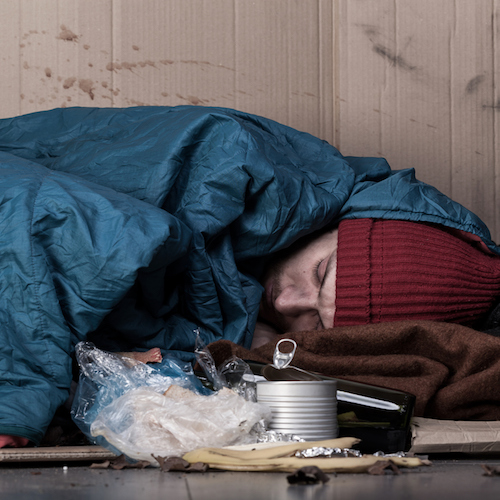
Published:
Last Updated:

There were an estimated 550,000 homeless people across the United States in January 2016, nearly 15,000 fewer than there were in the first month of 2015, a 3% decline.
The U.S. Department of Housing and Urban Development delivers to Congress annual estimates of homelessness across the nation. Based on the latest data from HUD, 24/7 Wall St. reviewed the share of each state’s homeless population that is unsheltered. These are individuals who are homeless, but are not staying in emergency shelters, transitional housing programs, or safe havens.
[in-text-ad]
California has the largest share of homeless residents who are unsheltered, at 66.4%. Washington state rounds out the list of 10 states with the largest shares of unsheltered homeless people — there, 40.6% of homeless residents are unsheltered. For reference, an estimated 32.1% of the 549,928 homeless individuals nationwide are unsheltered.
Click here to see the states with the highest shares of unsheltered homeless people.
Generally speaking, people become homeless because of strained financial resources and the challenge of finding affordable housing. Such factors as cost of living and median home value are therefore closely related to the incidence of homelessness. The cost of living in eight of the 10 states with the highest shares of homeless people — sheltered or unsheltered — is higher than the national average, and the median home value exceeds the national median of $194,500 in all 10 states without exception.
The homeless population is perhaps the nation’s most vulnerable group of people. Community members, non-profit organizations, state governments, and federal programs all work to lower the incidence of homelessness and help the homeless population, starting with providing temporary shelter. And while states with the largest unsheltered homeless populations tend to have high rates of overall homelessness, this is not always the case. In five of the 10 states with the largest unsheltered homeless populations, the ratio of homeless people to total population is lower than the national average of 1 in every 588 people.
The characteristics of the nation’s unsheltered homeless population sheds light on the conditions that can lead to more unsheltered homelessness. Compared with their sheltered counterparts, unsheltered homeless people are more frequently located in areas with warmer temperatures. People living in unsheltered situations are more likely to be veterans, have a history of incarceration, have lower levels of education, and significant substance use and mental health histories, according to the 2016 study in the U.S. National Library of Medicine, Homelessness, Unsheltered Status, and Risk Factors for Mortality: Findings from the 100,000 Homes Campaign.
Dr. Dennis Culhane is the Dana and Andrew Stone chair in social policy at the University of Pennsylvania and one of the principal researchers on HUD’s annual homelessness report. In an interview with 24/7 Wall St., Culhane said that in the areas with large unsheltered homelessness it is “not that there’s more homelessness, it’s that there is less shelter effort.” Even more than climate factors, the culture of helping and the general willingness among a population to assist people in need may account for the presence of temporary housing programs in an area, according to research Culhane continues to conduct across the United States.
Culhane’s hypothesis connects the current numbers of shelters in a state with the area’s broader traditions of social welfare provisions. Over time, philanthropic institutions such as churches, emergency housing programs, and even unions laid the foundation for the current high rates of sheltered homeless people nationwide. Culhane argued that this tradition is linked to the economic composition of states going back at least a century. In some, particularly southern and western states, there were fewer and less generous social welfare programs due to their economies: agriculture in the South and migratory workers in the West. “[T]hey wanted people to be compelled to work at the low wages that prevailed.” As a result, the infrastructure for supporting the homeless was not in place and sheltering efforts remain largely insufficient in these areas today.
All of the 10 states with the highest shares of unsheltered homeless people are in either the southern or western United States.
Numerous studies have demonstrated a link between rates of sheltered homeless people and safety net factors such as Medicaid spending. Medicaid can certainly have a direct impact on homeless individuals in need of health care, and it is also an approximation of the strength of social welfare programs in a state. Annual Medicaid spending per enrollee exceeds the national average expenditure of $5,790 in just three of the 10 states with the highest shares of unsheltered homeless people.
Click here to read our methodology.
Here are the states with the most unsheltered homeless people.
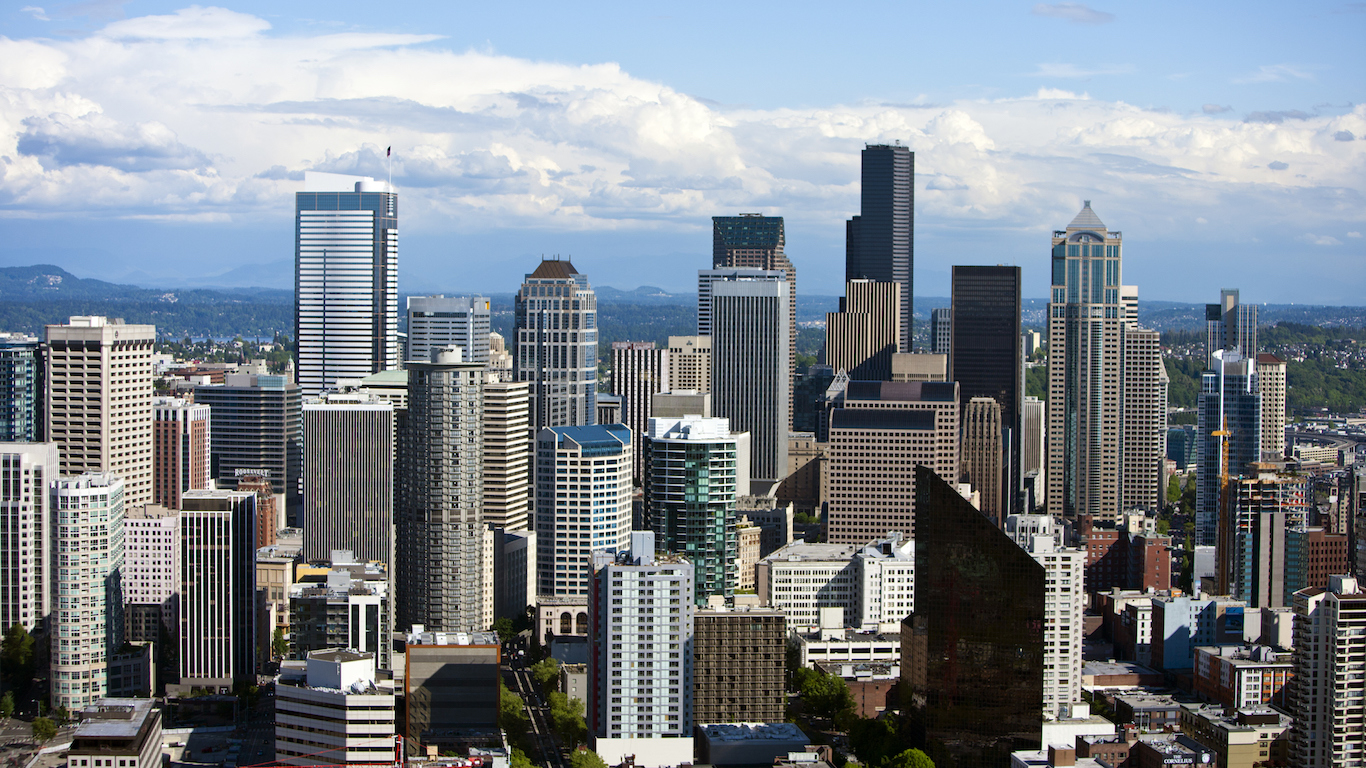
10. Washington
> Homeless w/o shelter: 40.6%
> Prevalence of homelessness: 1 in 349.9 people
> Homeless population: 20,827
> 2016 unemployment: 5.4% (tied – 9th highest)
Homelessness is more prevalent in Washington than it is in most states. About 1 in every 350 state residents is homeless compared to 1 in every 588 Americans. Homelessness spiked by 7.3% in Washington last year, even as it declined by 2.6% nationwide. Even when beds are available, homeless people do not always choose to go to a shelter. Even so, Washington appears to have insufficient infrastructure to take care of its homeless people. The combined capacity of all emergency shelters and transitional housing is only about 14,600, well below the roughly 21,000 total homeless individuals in the state.
Generally speaking, people become homeless because of strained financial resources and the challenge of finding affordable housing. Like a majority of other states with a homelessness problem, real estate is expensive in Washington. The statewide median home value is well over $250,000, far higher than the national median of $194,500.
[in-text-ad]

9. Georgia
> Homeless w/o shelter: 41.6%
> Prevalence of homelessness: 1 in 798.7 people
> Homeless population: 12,909
> 2016 unemployment: 5.4% (tied – 9th highest)
Georgia’s homelessness problem is improving relatively rapidly. In the last year, the state’s homeless rate declined by 6.4%, much faster than the national decrease of 2.6%. Even with this improvement, Georgia is one of only 10 states where over 40% of the homeless population sleeps in the streets. Safety net factors such as Medicaid can have a direct impact on homeless persons in need of health care, and it is also an approximation of the strength of a state’s social welfare programs. The annual Medicaid spending in Georgia of $3,992 per enrollee is second lowest of all states.
Mental illness and alcohol abuse are relatively common among the nation’s homeless. According to estimates by the Georgia Department of Community Affairs, about 2,600 homeless state residents have substance abuse problems, and about 1,850 are mentally ill.
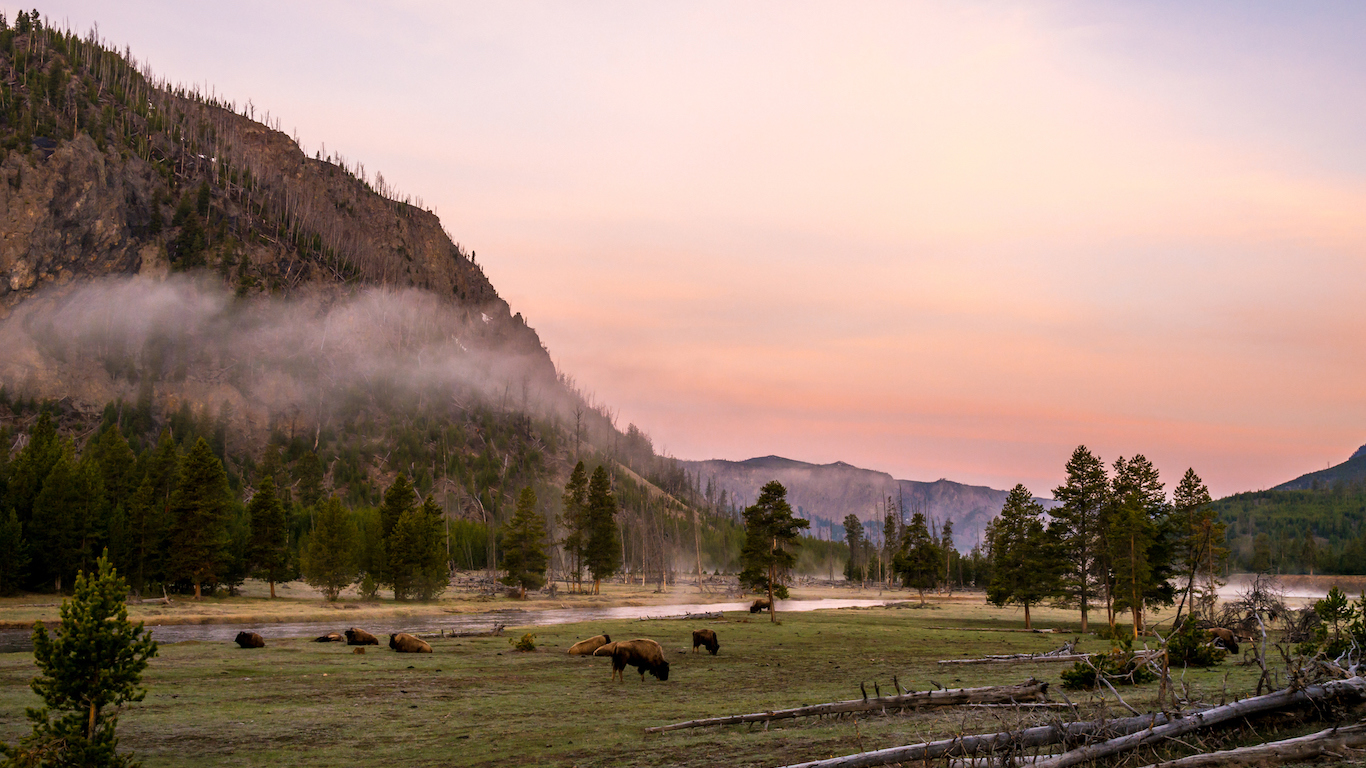
8. Wyoming
> Homeless w/o shelter: 42.7%
> Prevalence of homelessness: 1 in 683.2 people
> Homeless population: 857
> 2016 unemployment: 5.3% (tied – 13st highest)
Currently, homelessness is less common in Wyoming than it is across the country as a whole. There is one homeless person for every 683 residents, slightly below the comparable national ratio of one in every 588. This may not remain the case for long, however. Wyoming’s homeless population grew by 7.4% last year, the fourth largest increase of any state in the country. Meanwhile, national homelessness declined by 2.6% in 2016. Nearly 43% of Wyoming’s homeless population are without shelter, the eighth largest share of all states.
Due to a variety of factors, including historical economic conditions and climate, Western states tend to have relatively larger unsheltered homeless populations. Including Wyoming, seven of the 10 states with the largest shares of unsheltered homeless people are in the West.
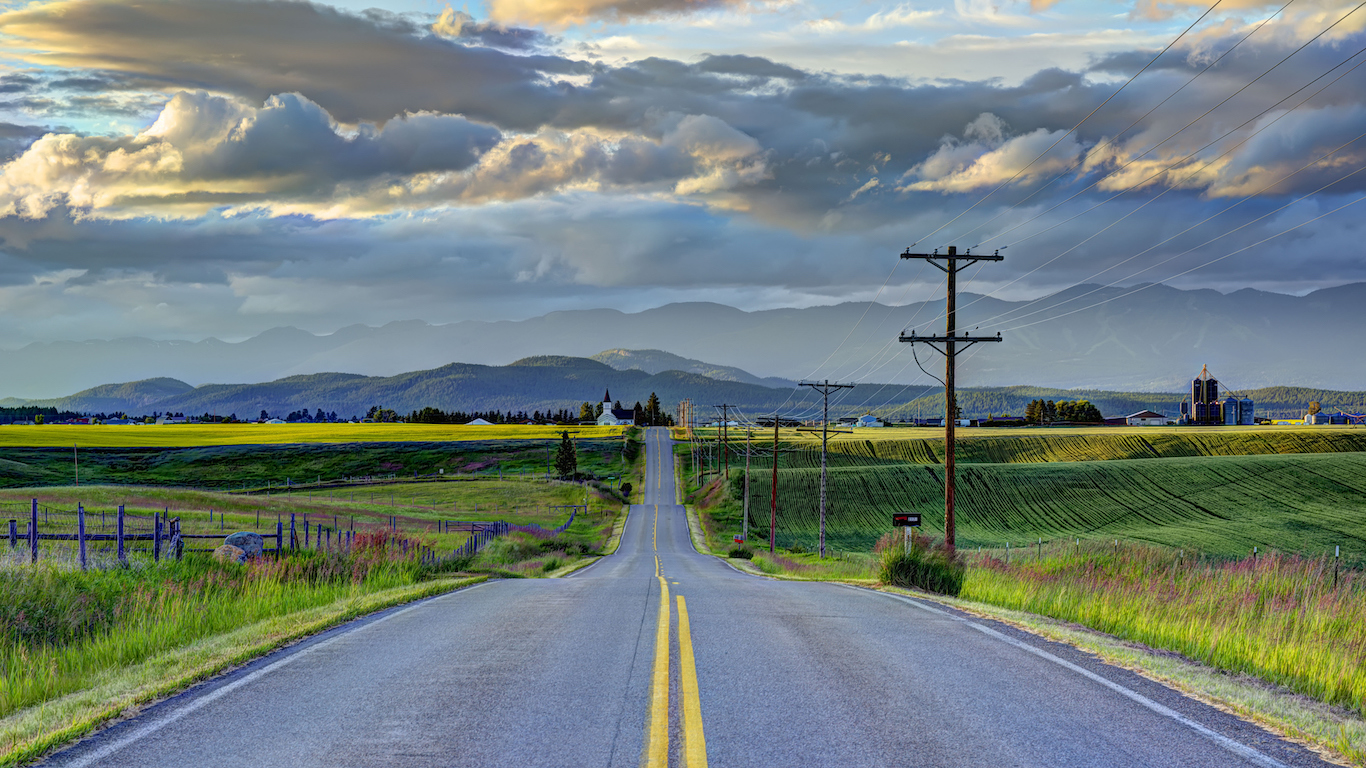
7. Montana
> Homeless w/o shelter: 44.4%
> Prevalence of homelessness: 1 in 735.2 people
> Homeless population: 1,418
> 2016 unemployment: 4.1% (tied – 17th lowest)
While homelessness is not particularly common in Montana compared with most states, the share of people who are homeless and without shelter is among the largest. Individuals with a military history are disproportionately represented among unsheltered homeless people across the country. In Montana, 10.6% of adults are veterans, the third highest share of any state, and 11.6% of all homeless state residents are veterans, sixth highest of all states.
While an especially large share of Montana’s homeless population is not living in shelters, many end up successfully transitioning into more permanent housing. The state’s homeless population is shrinking. The number of homeless people in the state decreased by 17% in 2016, nearly the greatest decline of any state in the country.
[in-text-ad]
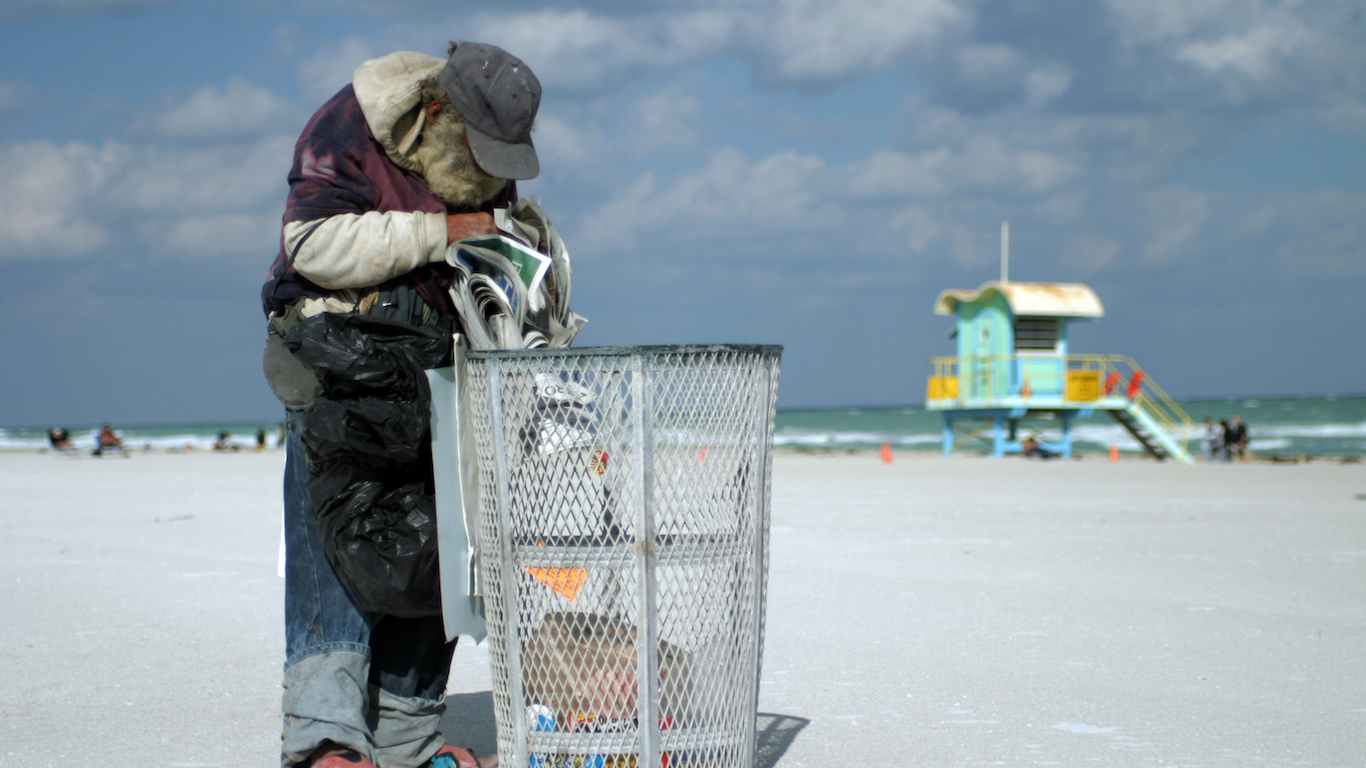
6. Florida
> Homeless w/o shelter: 45.8%
> Prevalence of homelessness: 1 in 614.2 people
> Homeless population: 33,559
> 2016 unemployment: 4.9% (tied – 20th highest)
Of Florida’s approximately 33,600 homeless people, only about 18,200 are sheltered. The large share of unsheltered homeless people may partially be the result of the state’s climate, as Florida’s homeless population is not often exposed to life threatening weather conditions, such as severe cold. As is the case in many other states, the large unsheltered homeless population may also be explained by a general lack of support for needy residents. For example, Florida’s annual Medicaid spending per enrollee is only $4,434, nearly the lowest of any state, and well below the comparable $5,790 national expenditure.
Florida is home to about 6.1% of the total U.S. homeless population, the third largest share of any state. However, homelessness is slightly less common in Florida than it is nationwide. Only about 1 in every 614 Florida residents are homeless, less than the national homeless rate of 1 in every 588.
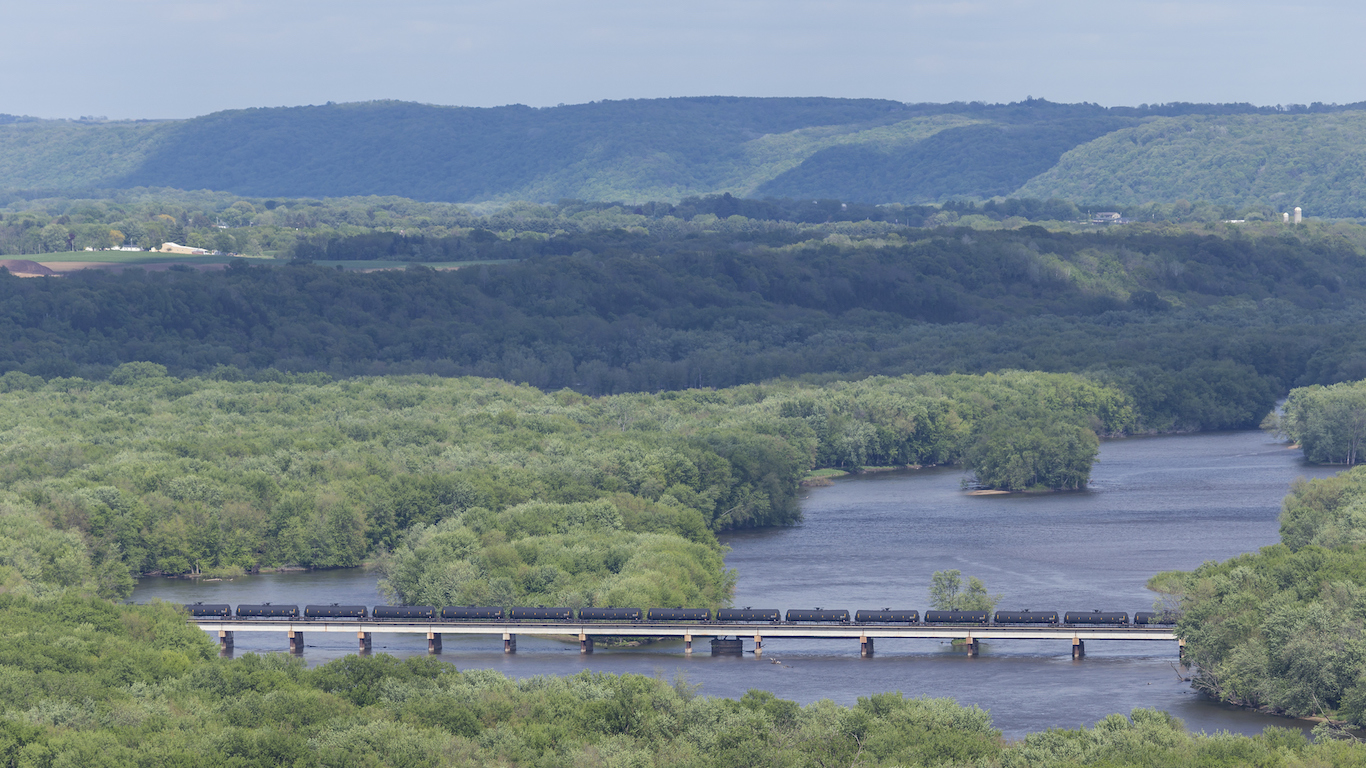
5. Mississippi
> Homeless w/o shelter: 48.8%
> Prevalence of homelessness: 1 in 1,719.6 people
> Homeless population: 1,738
> 2016 unemployment: 5.8% (7th highest)
Homelessness is an extreme form of economic hardship, by many measures, Mississippi is the poorest state in the country. Some 22% of state residents live in poverty, the highest poverty rate of any U.S. state, and 18.2% of state households rely on food stamps, the second largest share of any state.
Yet, due in part to the state’s low cost of living, only about one in every 1,720 people in Mississippi is homeless, the lowest homeless rate in the country. However, a disproportionate 49% share of the state’s homeless population are sleeping in streets, parks, cars, or otherwise not in shelters. The unsheltered rate among homeless veterans in Mississippi is even higher. Of the state’s 144 homeless veterans, 60% are unsheltered, the second highest such share of any state.

4. Nevada
> Homeless w/o shelter: 53.1%
> Prevalence of homelessness: 1 in 397.4 people
> Homeless population: 7,398
> 2016 unemployment: 5.7% (8th highest)
The prevalence of homelessness in Nevada is declining. The number of homeless people in the state declined by 15.4% in 2016, nearly the best improvement of any state in the country. Despite the reduction, Nevada is one of only four states where a majority of the homeless population is unsheltered. As is the case in many other states with relatively large unsheltered homeless populations, low levels of social welfare provision in Nevada may reflect a general unwillingness to support needy residents. The state’s annual per capita Medicaid expenditure of $3,728, for example, is the lowest in the country.
Nearly 93% of the state’s homeless people are homeless as individuals, not as a part of a family with children — the largest such share of any state. In comparison, only 65% of the U.S. homeless residents are individuals without children to support. As is the case across the country, homelessness in the state is considerably more common in urban areas. The vast majority — about 84% — of homeless people in Nevada reside in Las Vegas.
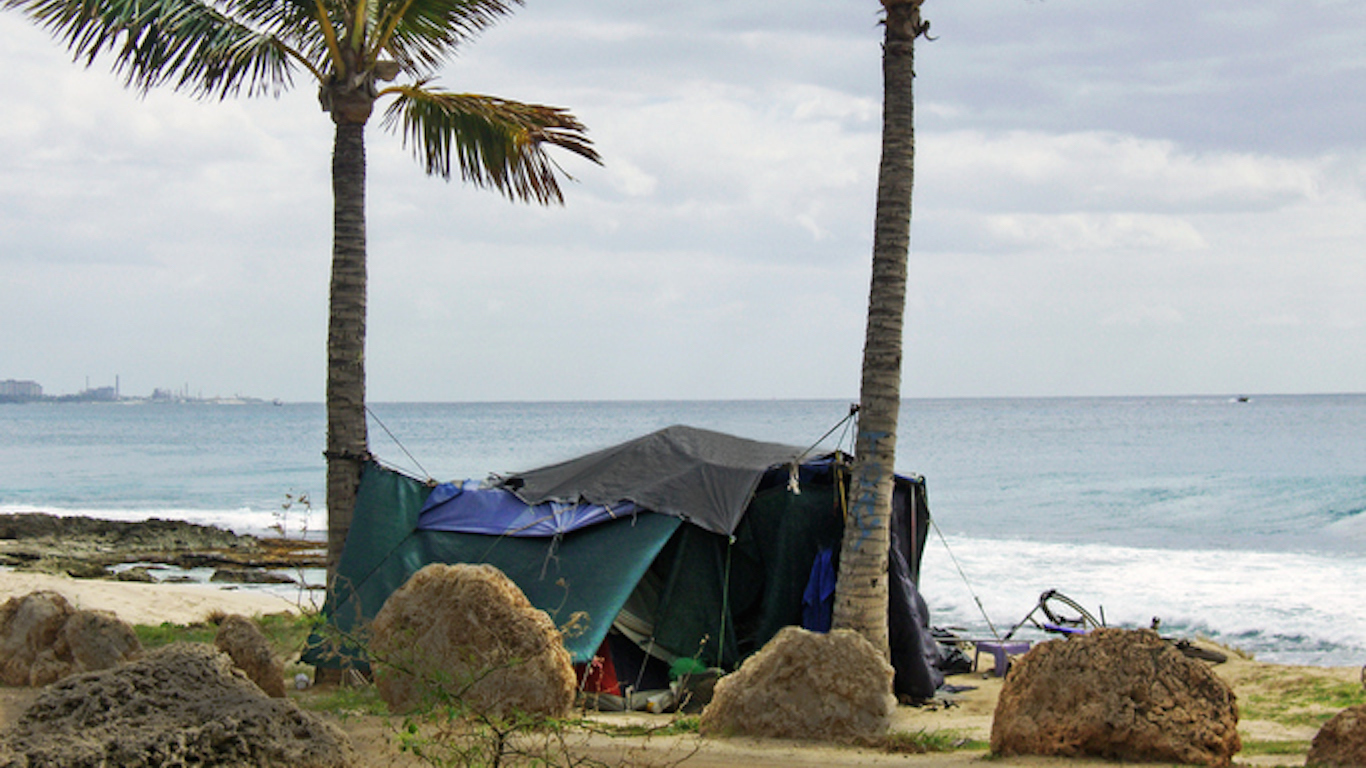
3. Hawaii
> Homeless w/o shelter: 54.4%
> Prevalence of homelessness: 1 in 180.4 people
> Homeless population: 7,921
> 2016 unemployment: 3.0% (3rd lowest)
Hawaii is one of only four states where a majority of homeless people are unsheltered. Families with children comprise about 42% of Hawaii’s homeless population, far higher than the comparable national share of 35%. Hawaii’s homeless problem is also getting worse. The state’s homeless population increased by 4.0% last year, even as homelessness decreased by 2.6% nationwide.
Generally, people become homeless because of strained financial resources and the challenge of finding affordable housing. Cost of living is among the many factors contributing to such hardship. While median income in Hawaii is one of the highest, the state is also the most expensive to live. Goods and services cost on average 16.8% more in Hawaii than across the nation, and the median home value of $566,900 is the highest of all states.
[in-text-ad]
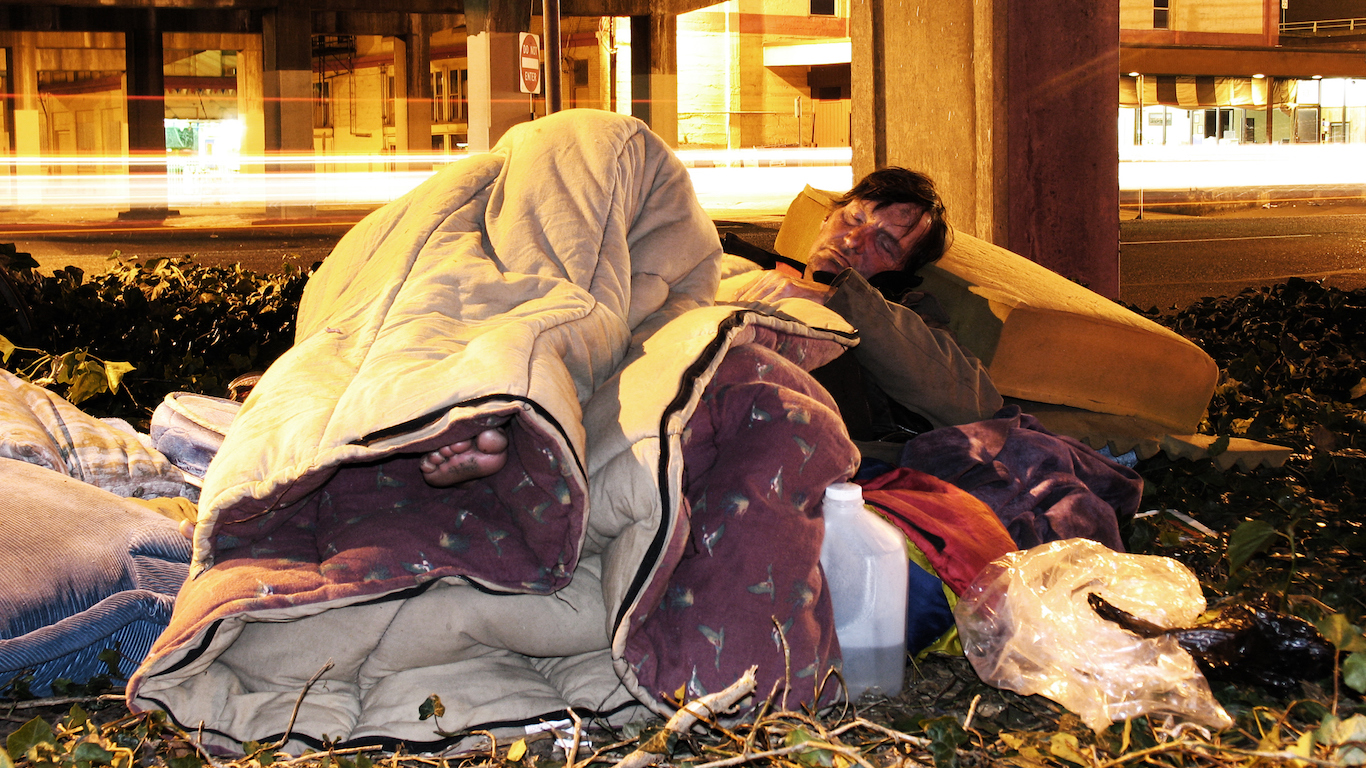
2. Oregon
> Homeless w/o shelter: 60.4%
> Prevalence of homelessness: 1 in 309.2 people
> Homeless population: 13,238
> 2016 unemployment: 4.9% (tied – 20th highest)
While Oregon trails just California in its share of unsheltered homeless residents, it leads the nation in its share of unsheltered people in families with children. Of the 3,859 homeless families with children in the state, 2,281, or 59.1%, are unsheltered, by far the highest such percentage. The percentage of Oregon households receiving government food subsidies is 18.6%, the highest of all states. The relatively high reliance on SNAP benefits in the state is an indication of financial insecurity and may help explain the homeless issue.
The problem is especially acute in Portland. The city’s mayor, Charlie Hales, declared in 2015 a state of emergency on homelessness, citing job losses and high housing prices as contributing factors to the skyrocketing homelessness.
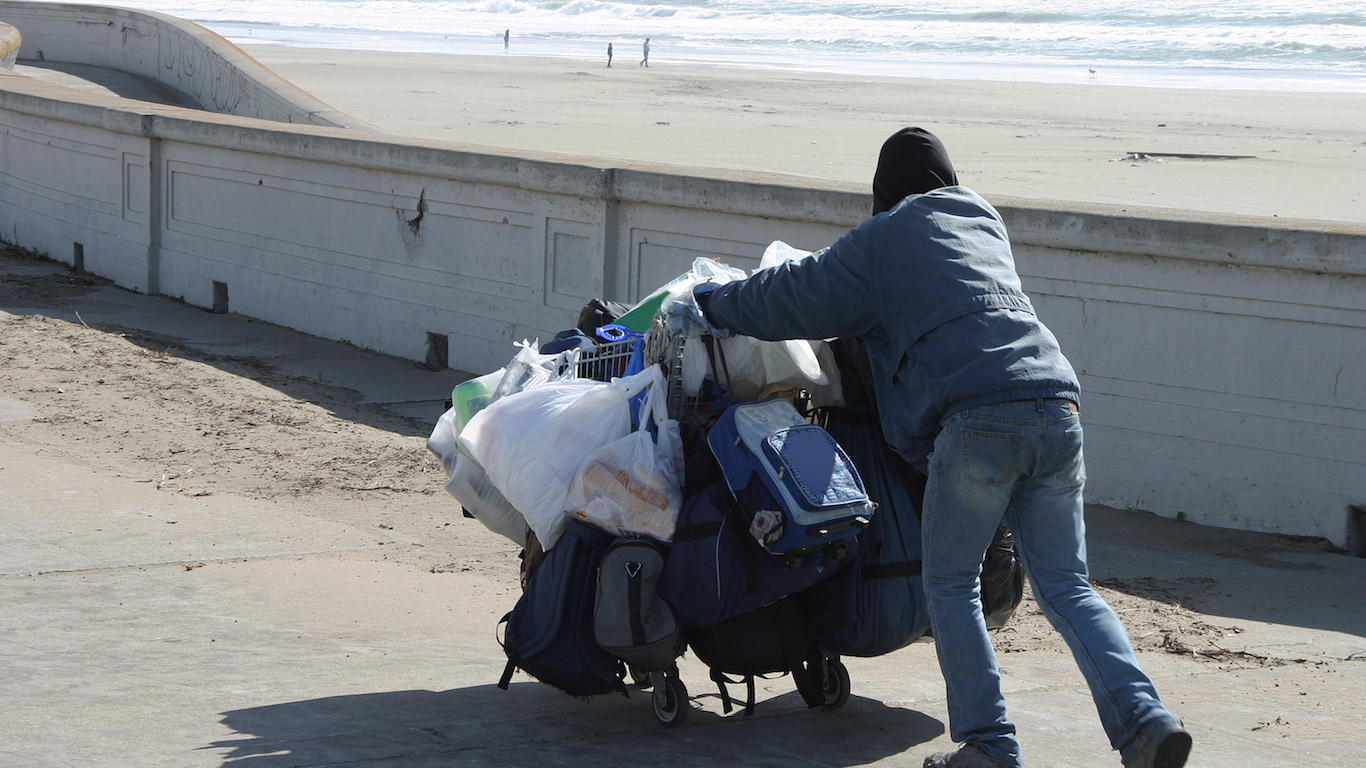
1. California
> Homeless w/o shelter: 66.4%
> Prevalence of homelessness: 1 in 332.2 people
> Homeless population: 118,142
> 2016 unemployment: 5.4% (tied – 9th highest)
Nearly two-thirds of California’s homeless population is unsheltered, the highest proportion of all states. Because of its large population, California is home to 21.5% of all homeless people living in the United States, by far the largest such share.
Homelessness is first and foremost a problem of affordability, and like other states with relatively large homeless populations, California is not especially affordable. Goods and services in the state cost on average 12.4% more than across the nation. The problem also does not appear to be improving. While homelessness has steadily declined across the nation — falling by 2.6% last year — California’s homeless population grew by 2.1% in 2016. In the summer of last year, Gov. Jerry Brown, in response to the growing problem, voiced his support for a $2 billion plan to build housing for the state’s mentally-ill homeless population.
Methodology
To identify the states with the most unsheltered homeless people, 24/7 Wall St. reviewed the percentage of each state’s homeless population that is unsheltered from The Department of Housing and Urban Development (HUD)’s report, The 2016 Annual Homeless Assessment Report (AHAR) to Congress Part 1: Point-in-Time Estimates of Homelessness. In part 1, HUD provides a snapshot of homelessness on a single night. The one-night counts are conducted in late January of each year. These are the most recent available data. Shelters include emergency shelters, transitional housing programs, safe havens, rapid re-housing programs, permanent supportive housing programs, and other permanent housing programs. The percentage of homeless people in families, in families with children, and the level of chronic homelessness — individuals who have been homeless for one year or more — also came from the HUD.
We also reviewed for each state the median annual household income, poverty rates, median home values, and the share of households receiving SNAP benefits (food stamps) from the U.S. Census Bureau’s 2015 American Community Survey. Cost of living in each state was obtained from the U.S. Bureau of Economic Analysis.
The thought of burdening your family with a financial disaster is most Americans’ nightmare. However, recent studies show that over 100 million Americans still don’t have proper life insurance in the event they pass away.
Life insurance can bring peace of mind – ensuring your loved ones are safeguarded against unforeseen expenses and debts. With premiums often lower than expected and a variety of plans tailored to different life stages and health conditions, securing a policy is more accessible than ever.
A quick, no-obligation quote can provide valuable insight into what’s available and what might best suit your family’s needs. Life insurance is a simple step you can take today to help secure peace of mind for your loved ones tomorrow.
Click here to learn how to get a quote in just a few minutes.
Thank you for reading! Have some feedback for us?
Contact the 24/7 Wall St. editorial team.